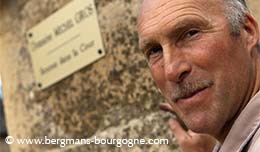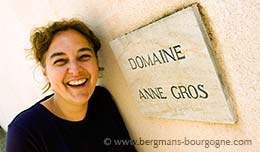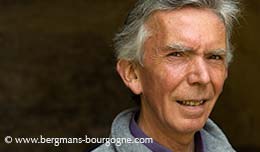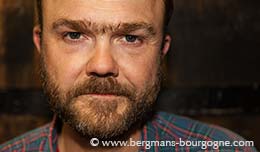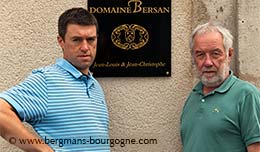
ierre Herouart is slowly bringing together two branches of the family. Since 2013 he has been taking on vineyards from his grandfather and his uncle, creating Domaine Pierre Herouart in Coulanges-la-Vineuse. Today the domaine covers 6.8 hectares. Over the past years he has replanted a total of 5.5 hectares, both in Coulanges-la-Vineuse and Irancy.
You’ll find Domaine Pierre Herouart just off the main street in Coulanges-la-Vineuse. A former coaching inn and post house this building now holds both the winery and the home of the Herouart family.
 – Since my uncle was already in the business it was easier for me to get started, says Pierre Herouart. The equipment was already in place. To start from scratch is something completely different. The vineyards are expensive enough. If you have to invest in equipment on top of that it’s going to be tough. And if you start from scratch you’ll need another job on the side until your business is profitable.
– Since my uncle was already in the business it was easier for me to get started, says Pierre Herouart. The equipment was already in place. To start from scratch is something completely different. The vineyards are expensive enough. If you have to invest in equipment on top of that it’s going to be tough. And if you start from scratch you’ll need another job on the side until your business is profitable.
Pierre Herouart’s uncle is Michel Martin of Domaine Michel Martin down by the entrance to the village. Retirement is approaching and the plan is to hand over the vineyards to Pierre step by step.
 – I left for Beaune in 2000 to start wine school. Later I did my internship with Michel and also ended up working for him. When I set up my own domaine in 2013 there was one hectare here in Coulanges-la-Vineuse of my grandfather’s vineyards I could start with. There was also 20 ares in Cailles in Irancy that I planted.
– I left for Beaune in 2000 to start wine school. Later I did my internship with Michel and also ended up working for him. When I set up my own domaine in 2013 there was one hectare here in Coulanges-la-Vineuse of my grandfather’s vineyards I could start with. There was also 20 ares in Cailles in Irancy that I planted.
The majority of Pierre Herouart’s vineyards are in Coulanges-la-Vineuse, a 30-minute drive southwest of Chablis. Here the appellation is the regional one with the addition of the village name, Bourgogne Coulanges-la-Vineuse. It comes in all three colours – red, white and rosé.
 – I mainly make red Coulanges, but there is a bit of white and rosé as well, says Pierre Herouart. The first year I sold all of my Coulanges to Les Caves de Bailly (the local cooperative) and my Irancy to my colleague Jean Marc Bon. In 2014 I began to bottle and sell some wine myself. Since then I have increased the sales in bottle. Today 90 per cent is sold to private customers in France. There is also some to cavistes and restaurants, but no export.
– I mainly make red Coulanges, but there is a bit of white and rosé as well, says Pierre Herouart. The first year I sold all of my Coulanges to Les Caves de Bailly (the local cooperative) and my Irancy to my colleague Jean Marc Bon. In 2014 I began to bottle and sell some wine myself. Since then I have increased the sales in bottle. Today 90 per cent is sold to private customers in France. There is also some to cavistes and restaurants, but no export.
The white Coulanges-la-Vineuse comes from a two parcels, one in the Montfaucon valley southwest of the village and one along the road to Escolives-Sainte-Camille on the opposite side of the village. The Montfaucon parcel was originally parcels of gamay planted by his grandfather. The vines only had approximately ten years of life left in them, so in 2013 Pierre Herouart decided to replant with chardonnay.
 – That part of Coulanges is good for white wines, explains Pierre Herouart. The soil is a bit Chablis-like there. I use 100 per cent stainless steel tanks for this wine.
– That part of Coulanges is good for white wines, explains Pierre Herouart. The soil is a bit Chablis-like there. I use 100 per cent stainless steel tanks for this wine.
There are two red Bourgogne Coulanges-la-Vineuse at Domaine Pierre Herouart. One straight Bourgogne Coulanges-la-Vineuse and one single vineyard cuvée from Terre Rousse, a lieu-dit on the south-facing slope right next to the village.
– The two cuvées are different both in terms of vineyards and vinification, says Pierre Herouart. For the main cuvée I use both barrels and tanks. Between one third and half of the cuvée, depending on the year, is made in barrel. For the Terre Rousse I only use barrels. No new barrels, because I don’t like too oaky wines. It’s not my thing.
– The Terre Rousse is young vines, he continues. It’s a parcel I got from my grandfather. It was just grass there. I planted vines and discovered that it made a really good wine, so I decided to bottle it separately.
 The main cuvée comes from various parcels around Coulanges-la-Vineuse, some planted in 1975 by Pierre Herouart’s grandfather, some planted by Pierre himself in 2013, 2014 and 2015. The wine from the youngest vines is sold off in bulk, while some is kept for the freshness. He is also working with 400-litre barrels in order in order to round off the wine.
The main cuvée comes from various parcels around Coulanges-la-Vineuse, some planted in 1975 by Pierre Herouart’s grandfather, some planted by Pierre himself in 2013, 2014 and 2015. The wine from the youngest vines is sold off in bulk, while some is kept for the freshness. He is also working with 400-litre barrels in order in order to round off the wine.
For the rosé Bourgogne Coulanges-la-Vineuse Pierre Herouart uses only pinot noir and a mix of methods. He uses the saignée method and then a bit of direct press.
– If you only do a saignée you may get a rosé which is too heavy, he says. If you do a bit of direct press you will add some freshness to the wine.
 There are two Irancy cuvées at Domaine Pierre Herouart. One is from two young parcels in Les Grandes Vignes, but labelled just Irancy. The other is a Irancy, Les Cailles. You’ll find Irancy seven kilometres east of Coulanges-la-Vineuse. While the latter only has a regional appellation Irancy has had its own village appellation since 1998.
There are two Irancy cuvées at Domaine Pierre Herouart. One is from two young parcels in Les Grandes Vignes, but labelled just Irancy. The other is a Irancy, Les Cailles. You’ll find Irancy seven kilometres east of Coulanges-la-Vineuse. While the latter only has a regional appellation Irancy has had its own village appellation since 1998.
– When I started in 2013 there was a parcel from my grandfather that decided to replant. At his time Irancy was still only part of the regional appellation, so the parcel was planted in white. I replanted with pinot noir and five per cent césar.
– Les Cailles has one third which was planted in the 1950s. The rest used to be gamay, but was replanted in 1996. In terms of soil Les Cailles is similar to Coulanges. Rather light with small stones, easy to work. It’s not too steep and the exposition is good. Les Grandes Vignes is south-southeast facing and mainly sees the sun from late morning to afternoon. Les Cailles is facing south and has sun all day.
Pierre Herouart points out that Irancy and Coulanges are always very different as wines. He vinifies them in exactly the same way, in the same cellar, and they are always different.
– It’s all thanks to the soil, he says. A Coulanges is easy to drink, but not necessarily light. It’s fruity and round. An Irancy is more tannic and structured. A Coulanges you can share with friends without any food. An Irancy without food is more difficult.
© 2019 Ola Bergman










